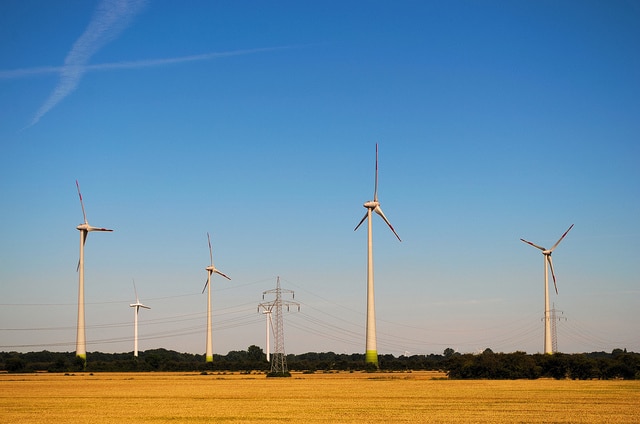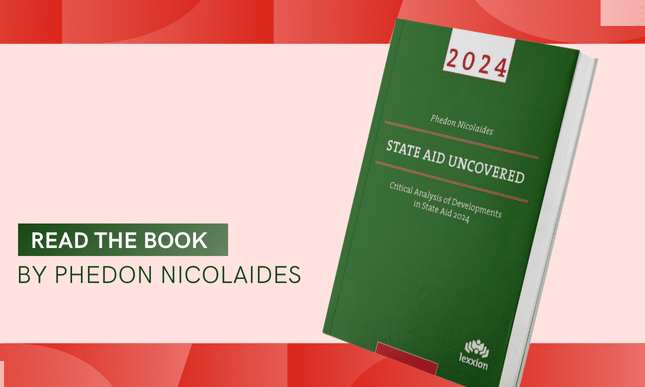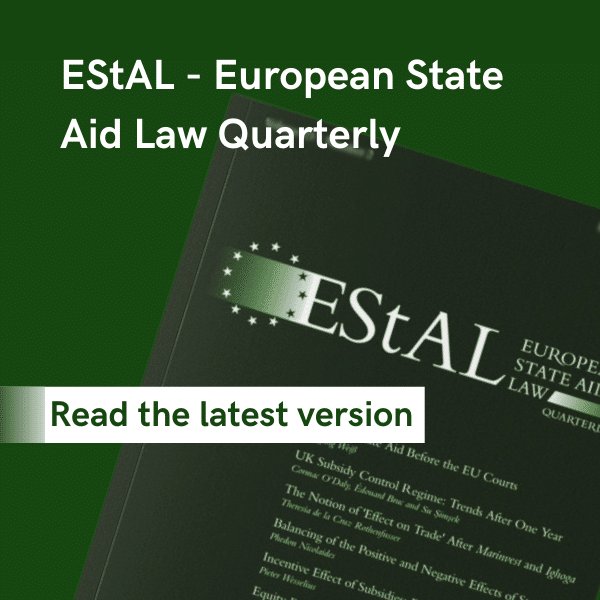
Arrangements established by law whereby undertakings are compensated for any extra payments they make to producers of green electricity are likely to bring those payments under the control of the state. Those payments will then be classified as state resources regardless of whether they are managed by private entities.
Introduction
On 10 May 2016, the General Court issued its much awaited ruling in case T-47/15, Germany v Commission[1]. Germany appealed against Commission decision 2015/1585 that had found that measures to support green electricity and to relieve electricity-intensive users [EIUs] from a green energy surcharge contained State aid. Some of that aid was incompatible with the internal market and had to be recovered.
Germany challenged primarily two aspects of the Commission decision. First, Germany was of the view that its measure did not involve any state resources. Second, the relief to EIUs did not confer any advantage to them because they suffered from a competitive disadvantage in relation to rival companies in other countries. The General Court rejected both of these arguments.
The German measure to support green electricity [EEG 2012]
Germany, like many other countries has adopted several measures to incentivise the generation of electricity from renewable sources of energy such as wind and solar power. In fact, Germany is the largest provider of environmental and energy aid. According to the Commission’s State aid Scoreboard, in 2014, the EU as a whole granted EUR 43.6 billion of aid for environmental and green energy purposes. Germany accounted for EUR 31.5 billion or 72%. Germany’s numerous measures have evolved over the years and the Commission has assessed them in their various transformations.
The measure that was the subject of this judgment was a law that regulated the production and supply of electricity, which was codenamed EEG 2012. It was quite complex but in essence it was structured as follows. Distributors of electricity were obliged to buy electricity from renewable sources of energy at prices or tariffs that were fixed by law. Because the production of green electricity is more expensive than electricity from fossil fuel, these “feed-in” tariffs were higher than the price of other electricity. When green electricity was sold on the electricity clearing market, distributors faced a deficit. This deficit was remedied by revenue they received from a surcharge that was imposed on electricity users. The EEG surcharge was levied according to conditions laid down by the EEG 2012. The EEG 2012 also provided for a reduction in the surcharge for EIUs, depending on the amount of energy they consumed. The higher the amount of energy, the lower the surcharge.
No central fund had been established by Germany to receive the proceeds of the surcharge and allocate the necessary compensatory amounts to electricity distributors. The proceeds of the surcharge were not paid into the budget of any public authority. Almost all of the entities involved were private. The only involvement of the state was to legislate the various rights and obligations of producers, distributors and users. In addition, this system of payments was supervised by the German energy network regulator. Hence, Germany argued that this arrangements very much resembled the arrangements in the case of PreussenElektra [C-379/98] that had been found by the Court of Justice in 2001 not to transfer state resources and, for that reason, to be free of State aid.
It should be noted that similar but ultimately unsuccessful arguments were made by the Dutch government in 2008 in Essent [C-206/06] and by the French government in 2013 in Vent de Colere [C-262/13]. The cases where the EU courts have found no use of state resources, apart from PreussenElektra, are very few. The landmark cases in this respect are Pearle [C-345/02], Deutsche Bahn [T-351/02] and Doux Elevage [C-677/11].
Advantage for EIUs
The General Court dealt first with the question whether EIUs derived an advantage. Germany argued that they benefited from no favour. The Court recalled established case law that State aid covers not only subsidies and other payments but also relief from charges, taxes and other levies that would otherwise have to be paid. [Paragraphs 53-56]
Then Germany claimed that EIUs had to bear the EEG surcharge according to their “ability to pay”. The General Court dismissed this claim. “(67) by its general and abstract line of argument relating to observance of the ‘ability-to-pay principle’, the Federal Republic of Germany merely asserts, in essence, that if EIUs had been burdened with the EEG surcharge at the full rate, they could have relocated their production abroad and, by so doing, would no longer have contributed to the financing of the funds generated by that surcharge. The Federal Republic of Germany does not, however, adduce any evidence in support of that line of argument. In particular, it does not demonstrate that it took individual account of the financial situations of the undertakings which benefit from the cap on the EEG surcharge or that, but for the cap, they would in fact have relocated their production”.
Do you know we also publish a journal on State aid?

The European State Aid Law Quarterly is available online and in print, and our subscribers benefit from a reduced price for our events.
The reasoning of the Court is incisive. In essence, it faults Germany for failing to define a credible counterfactual. What would have happened had they not been given relief [“but for the cap”]. For sure they paid more, but that in itself did not prove that they would shift production to other countries for the simple reason that shifting production is costly.
The Court also noted that even if EIUs were in a different situation than other users of electricity, Germany did not show how the relief they enjoyed was justified by the nature or general scheme of the EEG 2012 [paragraph 68]. Indeed EEG 2012 sought to support green electricity by transferring the burden on users of electricity according to their consumption and EIUs, by definition, consumed large amounts of electricity.
Use of state resources
The General Court began by reiterating that the concept of state resources also covered resources that were controlled by a public authority without entering the budget of a public authority or that of an entity that was controlled by a public authority [paragraph 81]. Then the Court listed the reasons for which the Commission took the view that the EEG 2012 involved state resources [paragraphs 84-90]:
- The EEG surcharge was introduced by the state and the network operators and distributors were designated by the state to administer the funds generated by the surcharge.
- The administration of the EEG surcharge by the operators and distributors was monitored by the German regulator.
- The EEG 2012 empowered operators to pass on the surcharge to consumers and enabled operators to be fully compensated. “(90) The Commission observed that State control over the resources does not mean that there have to be flows from and to the State budget involving the respective resources, but that, in order for the State to exercise control over the resources, it is enough that, as in this instance, it fully regulates what is supposed to happen in the event of a deficit or a surplus in the account relating to the EEG surcharge.”
The Court considered as decisive that the surcharge funds “(93) do not pass directly from the final consumers to the producers of EEG electricity, that is to say, between autonomous economic operators, but require the intervention of intermediaries, entrusted in particular with their collection and administration. It should be pointed out in particular that the funds are not paid into the TSOs’ general budget or freely available to them, but are subject to separate accounting and allocated exclusively to the financing of the support and compensation schemes, to the exclusion of any other purpose.”
“(95) The State has not only defined to whom the advantage is to be granted, the eligibility criteria and the level of support, but it has also provided the financial resources necessary to cover the costs of the support to EEG electricity. Furthermore, […], it has not been maintained by the Federal Republic of Germany, nor is there anything in the case file to indicate, that the initiative to impose the charge, by means of the measure at issue, was taken by entities liable to pay it, that the TSOs act solely as an instrument in an arrangement which those entities themselves envisaged or that they themselves decided on the use of the financial resources thereby generated.” “(96) In any event, those funds cannot be regarded as the TSOs’ own resources for which the State simply prescribed, by a legislative measure, a particular use, as the funds, […], are not at any time freely available to the TSOs.”
Comparison with PreussenElektra
Although the findings above are sufficient to conclude that the EEG 2012 resulted in transfer of state resources, the General Court proceeded to compare EEG 2012 to the PreussenElektra arrangements. In this connection, it observed that “(99) the mechanism laid down by [PreussenElektra] provided neither for the additional costs to be expressly passed on to final consumers nor for the intervention of intermediaries entrusted with the collection or administration of the sums constituting aid and, therefore, did not provide for entities comparable, in their structure or their role, to the TSOs taken together.”
“(100) Unlike in the present case, the advantage [in PreussenElektra] consisted in the guarantee, in favour of the beneficiary undertakings, of being able to resell all the energy produced from renewable resources and in the fact that the selling price exceeded the market price, without any scheme for the financing of that price supplement — by means of a charge that can be assimilated to a levy on electricity consumption, the amount of which is identical for each kWh of electricity supplied to a final customer — being set up.”
“(101) Furthermore, in [PreussenElektra] the private undertakings were not, as in the present case, appointed by the Member State concerned to manage a State resource, but were only bound by an obligation to purchase by means of their own financial resources. In the present case, it is not in dispute that the obligation on the TSOs that additional payment be made to producers of EEG electricity is not satisfied by means of the TSOs’ own financial resources, but by means of the funds generated by the EEG surcharge, administered by the TSOs and allocated exclusively to financing the support and compensation schemes set up by the EEG 2012.”
And it concluded that “(118) the fact that the State does not have actual access to the resources generated by the EEG surcharge, in the sense that they indeed do not pass through the State budget, does not affect, in the present instance, the State’s dominant influence over the use of those resources and its ability to decide in advance, through the adoption of the EEG 2012, which objectives are to be pursued and how those resources in their entirety are to be used.” “(120) The Federal Republic of Germany’s line of argument that the scheme supporting the production of EEG electricity does not impose a burden on the State budget does not mean that State resources are not involved in the present case.” “(122) he involvement of State resources in the present case results from the very fact that the State organises a transfer of financial resources through legislation and establishes for what purposes those financial resources must be used, and not from the existence of close links with the State budget.”
Conclusions
This judgment does not extend the scope of the concept of State aid. The views of the General Court on what constitutes a state resource are not revolutionary. However, the judgment makes it amply clear that the use of innovative administrative arrangements to escape from the clutch of State aid are unlikely to succeed. It supplements the comparison with PreussenElektra carried by the Court of Justice in Vent de Colere whereby the Court stressed that while in PreussenElektra the electricity distributors assumed risk [because there was no mechanism to compensate them for the extra cost of purchasing green electricity], in Vent de Colere, as in EEG 2012, the state made sure that distributors were compensated for the extra costs.
PreussenElektra, Pearle and Doux Elevage were exceptions. The involvement of the state was minimal. Any arrangement that defines with sufficient precision what is to be paid, to whom and how, and ensures that any deficit is covered by revenue from surcharges, is likely to confer to the state control over the payments involved. Then, State aid rules will apply regardless of whether the payments in question are managed by a private entity or that the state does not appear to forgo any revenue.
————————————————————-
[1] The full text of the judgment can be accessed at: http://curia.europa.eu/juris/document/document.jsf?text=&docid=177881&pageIndex=0&doclang=EN&mode=lst&dir=&occ=first&part=1&cid=114378.



